16/20 
 9.5 |
9.5 |  3 |
3 |  2 |
2 |  1.5
1.5
Thumbs up
- The best Tonkatsu in Tokyo, likely the world
- Watching the Chef was a performance in itself, like a highly trained Sushi Itamae at work
Thumbs down
- Reservations only
Recommended dish(es) – What to order at Narikura guide
- Those who like fatty cuts – Pork Rib (Bara)
- Those who like lean cuts – Chatonbriand (Tenderloin)
TL;DR – Skip Tonki Tonkatsu; the best Tonkatsu in Tokyo, and the world is at Narikura. The batter may be better at Tonta Tonkatsu, but the pork is better at Narikura. It may be one of the most expensive Tonkatsus and requires reservations, but there is no other Tonkatsu that comes close.
Table of Contents
The best Tonkatsu restaurant in Tokyo
“Ton-fkn-katsu.”
The 3 noises that blurt out of my mouth upon my first bite, my mind too absorbed in processing how this mere piece of pork could taste so great to form coherent sentences. But why was I here, having mindblowingly good Tonkatsu? To answer that, we must go back a step.
I didn’t always like Tonkatsu. After all, what was there to like? A deep fried thin piece of chewy pork that made cardboard seem juicy by comparison. How wrong I was.
You like pork belly right? And you like fried chicken right (don’t lie, we all do)? Well, good Tonkatsu tastes like the combination of both; tender and juicy pork, perfectly deep fried with a light crispy crust to seal in all the juices.
So when I went on my food pilgrimage of 2014, I decided to seek out the best Tonkatsu in Japan, one where the chef had been perfecting their craft over several generations. I discovered that Katsuzen is the only Tonkatsu restaurant in the world to have a Michelin star, but to my surprise, it was not that well regarded by locals or critics, ranking only 10th in Tokyo by the trusted Tabelog. What’s 1st? You guessed it, Narikura.
Chef Seizo Mitani-san. Photo credit – @yewwooi
Despite the Tonkatsu at Narikura surpassing my wildest expectations, I felt an incredible sense of sadness. Sadness that Tonkatsu is misrepresented to so many people around the world, sadness that, as a result, Tonkatsu is not more popular, and sadness that many may never have the privilege of having Tonkatsu as it should be.
But all is not lost. If you are ever in Tokyo, eat at Narikura even if you hate Tonkatsu with a passion. Because I’m willing to bet that after one bite at Narikura, you’ll only be able to say 3 words – “Ton-fkn-katsu”.
This isn’t even my final form.
It was almost surreal, like something from an anime. To see this lone chef, whose skill had been honed over generations, brow furrowed from concentration on this single cut of pork. Contrast this to the rest of the world, where Japanese restaurants treat Tonkatsu as an after thought, one of the many items on the menu.
Each cut was individually sliced, breaded and fried to order. The way the chef treated the meat was as if he was preparing the finest cut of Matsusaka Wagyu. But no, it was “just” a cut of pork, a damn good one at that.
The world seems to be inspired by Sukiyabashi Jiro (Jiro Dreams of Sushi); his dedication, his skill, his relentless pursuit of perfection. But the thing I love about Japan is that this philosophy is ingrained in their culture, that the story of Jiro is just one of many stories across Japan. This is the story of Narikura.
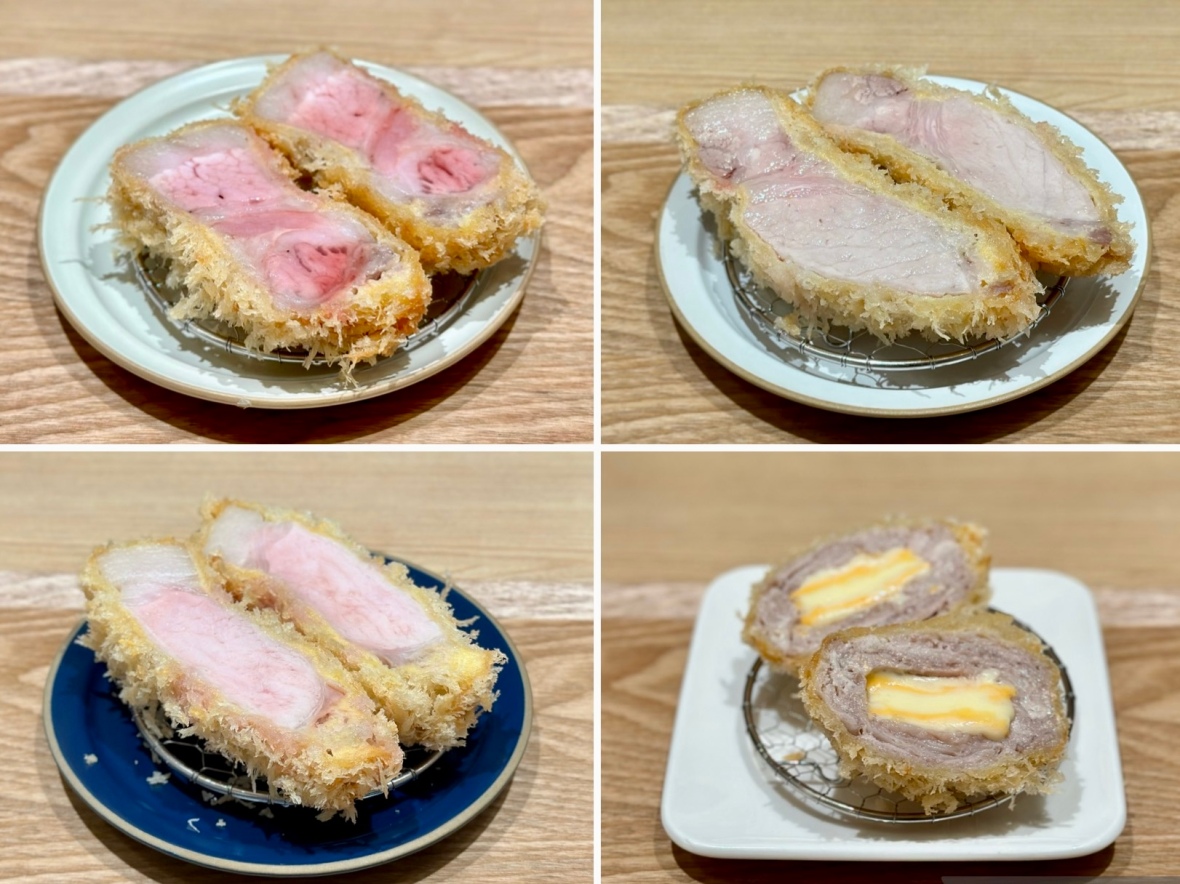
Eating Narikura’s pork was like eating Wagyu for the first time. It was so much juicier and more tender that I could not believe it was actually pork. Like Wagyu has ruined me for all other beef, this may well have ruined me for all other pork.
And the perfect panko crust, crispy enough to provide crunch but soft enough to melt away, once in your mouth, to give way to the flavours of the pork.
I’ve always believed that actions speak louder than words. I ended up coming back to Narikura three times in my short 8 day stay in Tokyo, and in a city where you can find the world’s best sushi, wagyu and tempura, that means a lot.
For more personalised advice, customised food itineraries and to unlock your best culinary adventure, please contact me.
Narikura (成蔵)
4-33 Naritahigashi, Suginami City, Tokyo (map)
https://tabelog.com/en/tokyo/A1319/A131905/13236380/
What to order at Narikura
First things first. Don’t be late, don’t be that guy to ruin it for the rest of us. As you can tell by how punctual the transport system is in Japan, it is deeply disrepectful to be late to any Japanese reservation and will have an impact on all the customers after you.
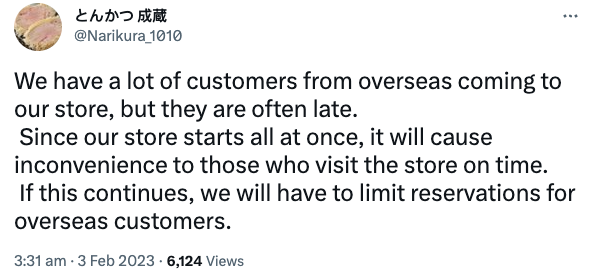
So now that you’ve arrived on time, Narikura’s English menu is lacking some detail that’s in the Japanese menu, so here’s guidance on what to order in very thorough detail (which makes for excellent reading material on the train ride there).
Note – this guide is accurate as of 12/12/23. I will do my best to keep this updated if and when Narikura changes their menu.
I was initially sceptical about Narikura’s new course structure, given my general dislike of course meals. However, I realised that unlike other course meals, the course structure actually reduces rigidity.
It makes the experience more flexible because it allows you to choose exactly what part of the rosu (loin) you would like to eat. If you’re one of those traditional rosu only people, just order all 3 rosus cuts (Bara, Ribeye, Special Loin) – you’ll basically get the full rosu.
But the new course structure allows me to order a combination that I’ve always wanted but never have been able to before – Bara (belly, the fattiest part of the rosu) with the hire (fillet). This gives me the best of both worlds. The fatty belly end of the loin, but instead of the loin meat which is abit chewier, I can get the soft melt in mouth fillet.
Another benefit of a course menu is that rather than having your last few pieces Tonkatsu cold, by being served two pieces at a time, it allows every bite to stay hot and crisp.
The Cuts
Loin (Rosu) or Fillet (Hire)?
From fattiest to leanest (with the unique creations at the end) –
- Bara (Belly) – Loin
- Ribeye (Rib Roast) – Loin
- Special Loin – Loin
- Cha-“ton”-briand – Fillet
- Cheese Mille-feuille Cutlet – Unique creation
- Mille-feuille Cutlet – Unique creation
If you prefer your pork with more fat, focus on the loin cuts (rosu/ロース); if you prefer leaner and more tender pork, focus on the fillet cuts (hire/ヒレ). For those who are more familiar with beef, pork loin is equivalent to a beef sirloin while pork fillet is equivalent to a beef eye fillet. Detailed information on each cut below.
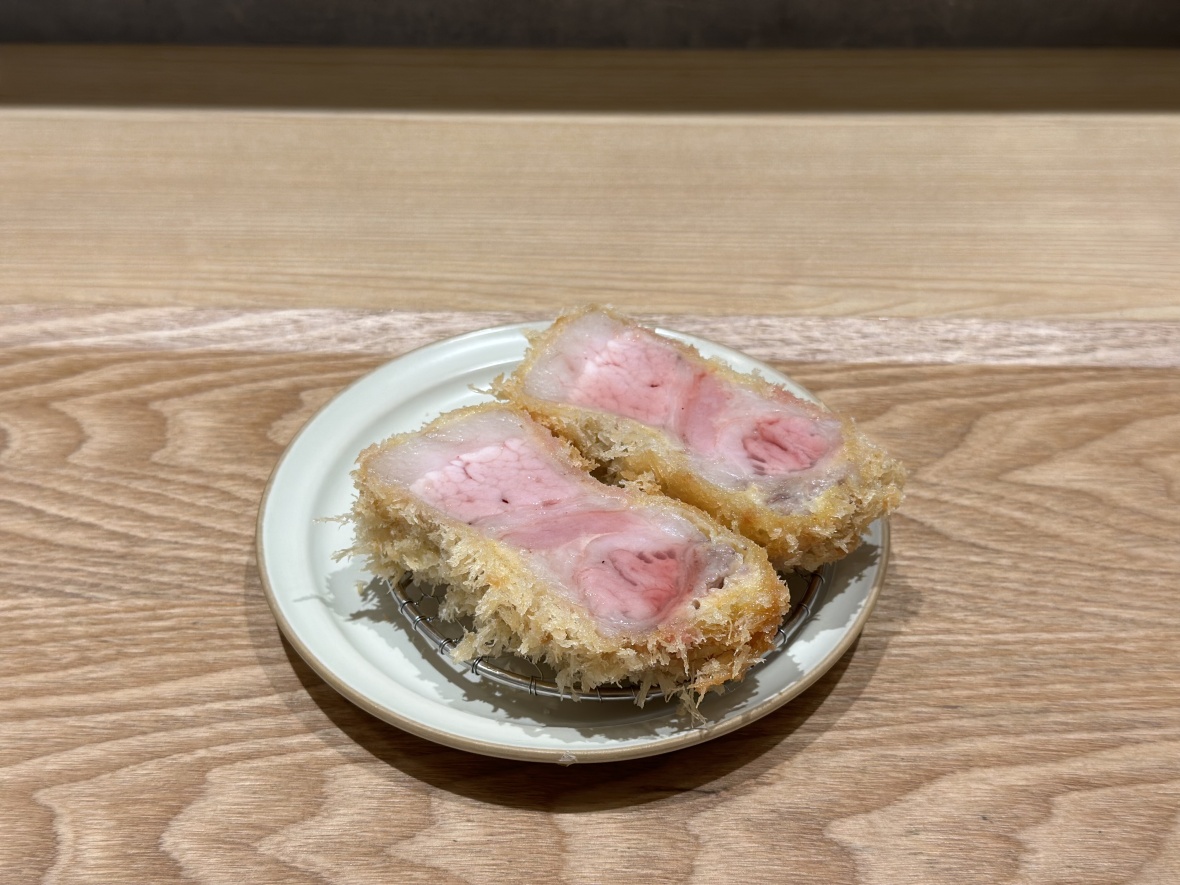
Bara/Belly/Rose Cutlet (バラかつ)
- This is effectively the belly meat around the pork rib.
- It is called “three-layered meat”, as the fat and meat alternates.
- The fattiest cut of pork available – juices will literally explode into your mouth.
- For me, this is the singularly best bite of tonkatsu you can have (bearing in my my preference towards fatty cuts), but it is heavy so offset this cut with something leaner.

Ribeye/Rib Roast (リブロースかつ)
- The uppert part of the loin, closer to the shoulder.
- Similar cut/positioning to a beef ribeye.
- Considered the highest quality meat on a pig.
- Meat quality is similar to the rest of the loin, but has more marbling.
- Deepest and richest flavour of all cuts.
- The most balanced meat to fat ratio of all cuts, with the outer edge fat containing umami and many other distinctive flavours
- The fat and lean meat are both outstanding and well-balanced.

Special Loin (特ロースかつ)
- Uses the softest part of the center part of the loin.
- The texture of the meat is finely textured and is the most tender loin cut you can get.
- Also the leanest loin cut you can get

Fillet/Hire (ヒレ). Photo credit – Narikura
“Chatonbriand” (シャ豚ブリアンかつ)
- Signature fillet cut. Best with sesame oil.
- Only ~500g of this cut is available in each pig.
- Made using the softest part from the center of the filet meat.
- Fillets are often dry, but the low temp frying that Narikura uses keeps them “so juicy”. The chef would like people who normally prefer loin to try this.
- For beef, this cut is called “chateaubriand”. Chatonbriand is a play on the words where “ton” (豚), the Japanese kanji for pig, has been slotted in. The name itself is trademarked to Narikura.
- This cut is extremely rare as it is only 1.4 – 1.7% of the carcass weight and there is only enough to make one serving in a filet that is 20cm or longer.
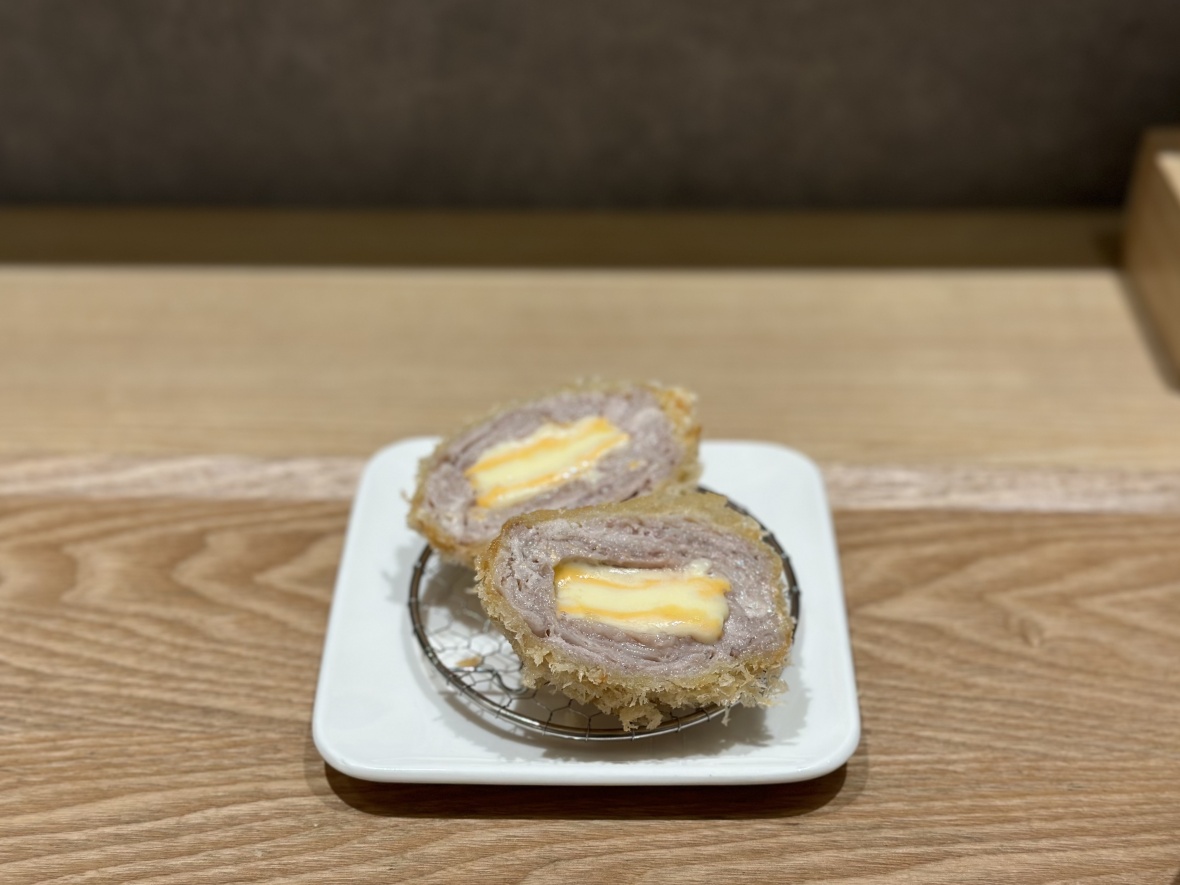
Cheese Mille-feuille Cutlet (チーズミルフィーユかつ)
- Specialty pork loin is sliced very thinly using a meat slicer in store, before being layered in a mille-feuille shape.
- It creates a very unique juicy and melt-in-mouth texture as it is condensed by putting the lean meat and fat from the loin in a well-balanced manner.
- Three kinds of cheese are sandwiched between the slices of pork.
- Served with sweet chili sauce.
Mille-feuille Cutlet (ミルフィーユかつ)
- Same as the Cheese Millefeuille Cutlet but without the cheese.
- Personally, if I want to go for novelty/unique, I will always add cheese.
Whatever cut you choose, please taste the first bite without condiments to appreciate the flavour of pork. Then use tonkatsu sauce, sesame oil or rock salt, one piece at a time, to avoid a soggy panko crust.

Non-pork Katsu Add-ons
Narikura also has other katsus depending on availability of the day. I prefer his pork over all his other katsus (and I prefer the seafood katsu at Ponta Honke anyway) but if you’re looking to mix things up, below is what I recommend in order of preference –
- Chicken
- Shirako (mostly because it’s unique)
- Oysters
- Aji (Horse Mackerel)
- Prawn
- Mince Cutlet
The Specialty Breeds
Pork marbling. Photo credit – Narikura
With the new course menu structure, you will be choosing the cut you would like rather than the breed you would like. The breed is selected based on quality and availability on the day.
Regardless of what breed you get, it will be excellent but below is an outline of the specialty breeds that may be available, for your reference –
Tokyo X – Several Prefectures
- My personal favourite, and one of the highest quality pork breeds I’ve come across.
- Tokyo X is a new purebreed developed in search of the ultimate taste.
- It has dense, fine and silky smooth muscle fibres with fat that has a very low melting point and a fragrant nutty aroma. It is rich in intermuscular fat (marbling)
- Strict standards have been established for feeding management, and production is carried out accordingly.
- Fed with non-GMO corn, soybeans, carefully selected milo, barley, rice, bran and legume grass alfalfa.
- Rice feed helps lower the melting point of fat
- Blending 12.5% bran and legume grass alfalfa results in feed that is rich in fibre, activating the pig’s intestines allowing it to grow healthy and relaxed.
- Tokyo X is managed based on four principles since 2009 – Safety, Biotics, Animal Welfare and Quality.
- Tokyo X pigs are grown in Miyagi Prefecture, Ibaraki Prefecture, Yamanashi Prefecture, and Nagano Prefecture.
Iwachu buta/Rock Pork (岩中豚) – Iwate
- Light taste.
- SPF (Specific Pathogen Free) – the pigs are checked once a year to ensure that it is free of harmful pathogens.
- Results in healthier pigs that have no smell and less acne (who knew pigs could get acne).
- SPF is achieved through pigs with less stress, raised in a more spacious environment. Feed is a blend of wheat, barley and vitamin E.
- This pork has 3 times the amount of vitamin E compared to normal pork, which prevents meat deterioration and drip loss.
- Also offered at Butagumi.
Yukimuro-Jukusei buta/Snow-aged Pork (雪室熟成豚) – Niigata
- Personally a bit underwhelmed by this (though I’ve always thought wet-aging is cheat/shortcut and results in an inferior product).
- Snow-aged between 0-5℃ and between 89-95% humidity.
- During the ageing process, the meat fibres break down (more tender) and free amino acid increases (umami taste becomes stronger).
- It is vacuum wrapped so it’s essentially wet-aged pork, using snow to control the temperature rather than a traditional fridge.
- A “snow room” is supposedly superior as it is not temperature controlled and does not require defrosting, resulting in an indoor environment that can age at a constant temperature and humidity.
- Snow-ageing has also been used for rice, fruit trees and vegetables to increase sweetness, vitamins and umami flavour.
- Given that dry-aged is known to produce a superior product than wet-aged, I wonder why there are little people who dry-age pork.
Contrary to popular belief, Tonkatsu is deep fried at a low temperature of 140°C for about 20 minutes. This maintains the juiciness of the pork and ensures a crisp crust.
—
So fellow foodies, what’s the best pork dish you’ve ever had?
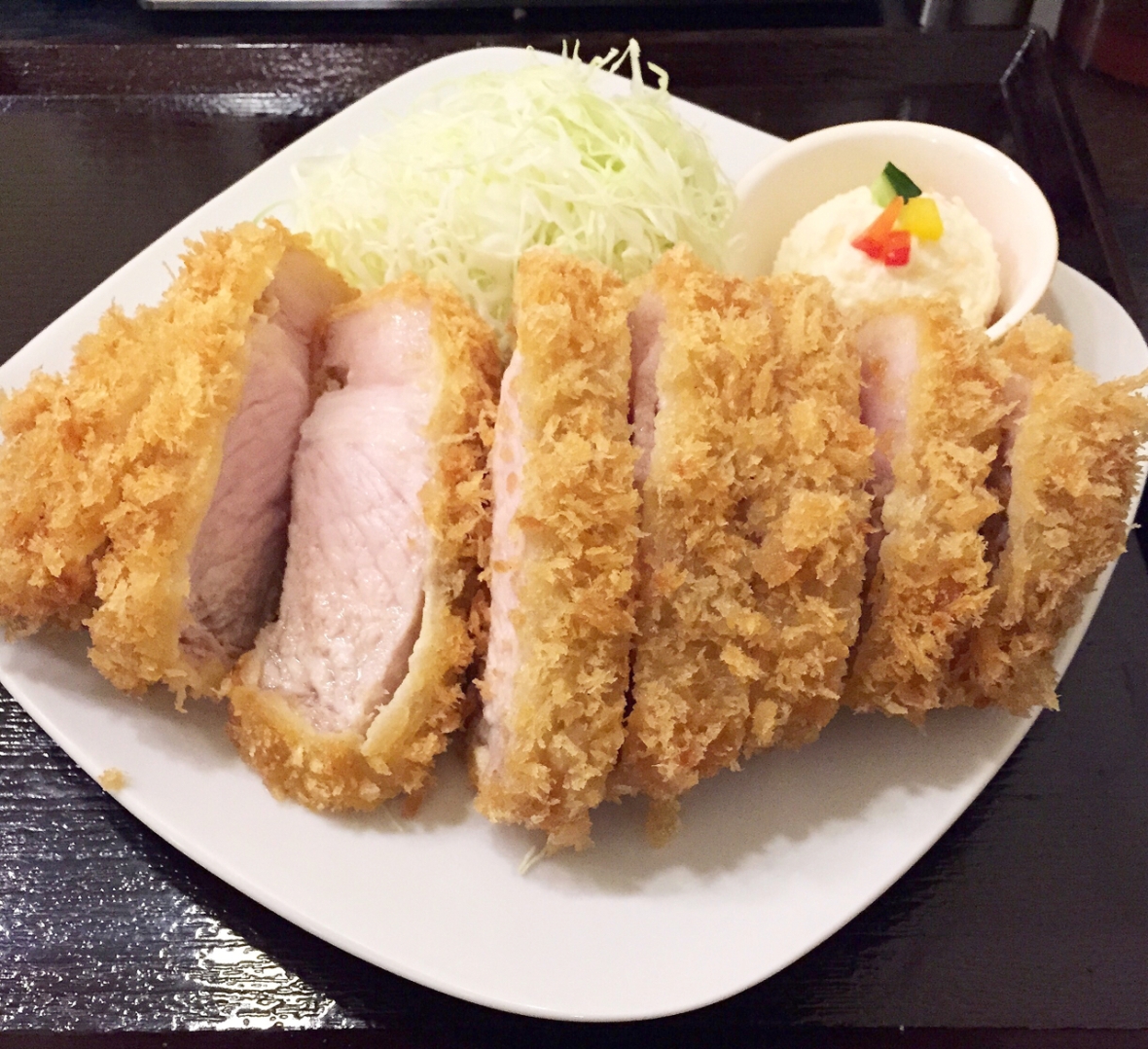
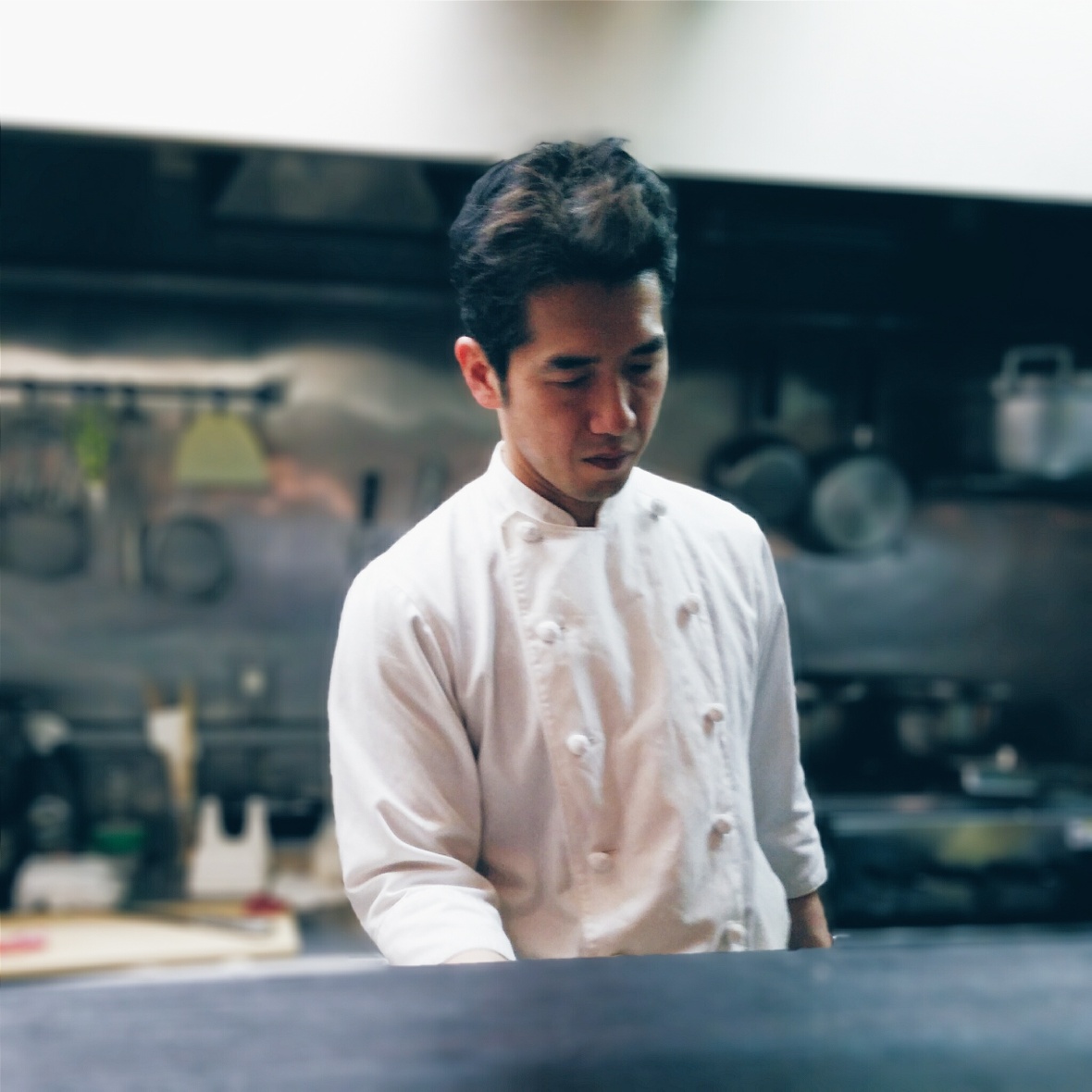






I am totally in agreement here. I’ve had two places for tonkatsu and this place was clearly the winner by a mile. Thank you for the detailed review.
LikeLike
Thanks for reading and your support 😊
Narikura really is that great and is one of my must eats in Tokyo. I’m curious, what were the other two tonkatsu places you went to in Tokyo?
LikeLike
LOVE your blog!
LikeLiked by 1 person
Thanks mate 😊 thanks for reading!
LikeLike
Hi, do you need to make reservations at this place?
LikeLiked by 1 person
No reservations required (or allowed). Go early or late though, otherwise you’ll have to wait around 30 mins.
Thanks for reading!
LikeLike
Very helpful, thanks!
LikeLike
No worries 😊 enjoy Narikura!
LikeLike
Hi,
I was trying to book nakahara as well, but the concierge told me they didn’t take phone reservations. What’s the best way to get seats?
Regards, Yuhun
LikeLiked by 1 person
Hi Yu,
The best place is through Pocket Concierge. The link is in my Nakahara review 😊
LikeLike
Hey Eric,
Just went this week, based on your recs. Have to agree, this is the winner from all accounts. I have to say I ordered the large cut (@3,900 yen) of sirloin as I like my meat fatty “Loin (ロース)” – the queuing made me hungry.
Meat was absolutely spectacular. I swear this was almost looked like wagyu beef disguised as pork! The cut I had looked even fattier than the ones here. Really well-marbled. Not forgetting the lighter style of the batter. It’s of a lighter color than the usual ones which are darker brown. I liked that too, but really couldn’t focus with how good the pork was.
Will definitely be back. Great article.
Yuhun
LikeLiked by 1 person
Thanks for the kind words and the feedback 😊 can I ask, which breed of pork did you get? Was it a standard breed or one of the specialty breeds?
LikeLike
Eric,
If I remember, it was on the right side of the menu. And the fatty cut ‘sirloin’. Whole menu is in Japanese so that didn’t really help. But I did take a picture of the menu, so hopefully someone who understands Japanese can translate. I’ll email you the picture.
Regards,
YH
LikeLike
Eric,
Here you go, picture of the menu.
Fatty one is the one on top
[image1.JPG]
Here’s a picture of it, largest cut
[image2.JPG]
Regards, Yuhun
LikeLike
This place looks fantastic.
Im visiting Japan in December, so I’ll pay this tonkatsu restaurant a visit at lunch.
Booking high end sushiyas or kaiseki restaurants in Japan is a nightmare, so im glad i cant just step in here and have meal
Great review btw!
LikeLiked by 1 person
Thanks for reading and the kind words!
Yeh booking high end restaurants can be a pain, especially when you just want the flexibility of waking up and eating what you want. I would recommend Shimada as well, in terms of places you can step in and have a meal. Kaiseki style food, in a more casual standing izakaya setting.
Let me know how your thoughts on Narikura when you visit 🙂
LikeLike
Impressive and useful information. Thank you! Was curious about Nakinura’s new spot. Will be in Tokyo in May. Any help is appreciated.
LikeLiked by 1 person
Hello,
Fantastic review and photos – I will be going to Narikura in December because of your review. I just have a few quick questions if you don’t mind.
1. How would you suggest someone who can’t read or speak any Japanese to order from the menu at this restaurant? Can they speak and explain the menu in English?
2. Since you said not all the specialty breeds are available at one time- which breed and cut do you recommend for someone who doesn’t like too much fat or too lean but somewhere in between?
3. Aside from the 3 specialty breeds you mentioned do they ever have any other better breeds?
Thank you!
LikeLiked by 1 person
Hi Joseph
First of all, thanks for reading. No problems with the questions.
1. The staff at Narikura can’t really speak English. However the menu is pretty small, so there isn’t an overwhelming number of items to choose from
2. I would recommend Kuramugi Ton. You can either go for the loin (ro-su in Japanese) or fillet (hi-re). Loin is fattier and my usual cut. It’s similar to the Sirloin on a steak. The fillet is similar to Tenderloin/Eye fillet steak, supremely tender but little to no fat. If you do go the loin, I would recommend the 190g or 120g cut. The 250g cut is cut from the centre of the pig which is usually the fattiest (and probably too fatty for you)
3. The breeds depends on their season. I’ve been recently and currently they have a Kagoshima Black Pig, Kiramugi Ton and an Ice Cured pork. Having had all of them, my favourite is the Kiramugi Ton. Each specialty breed is given a full page and is in the centre of the menu (first page being an explanation of the cuts, the last page being the normal menu). The Japanese words for Kiramugi Ton and Loin/Fillet are in the review so you can line it up with the menu.
Let me know if you have any other questions. Hope you enjoy! 😊
Eric
LikeLike
Hi Eric,
Thanks for the recommendation. Had the Kiramugi pork as well.
Made a video on it:
Cheers,
Brian
LikeLiked by 1 person
Nice! Glad you enjoyed it!
LikeLike
OMG, I am so amazed by this blog post on Narikura. THANK YOU SO MUCH for posting it. I will bookmark this forever!
LikeLiked by 1 person
No worries, glad I could help more people enjoy what I think is the best tonkatsu in the world. Thanks for reading 🙂
LikeLike
I spent 3.5hrs waiting in line. After an hour it started raining a bit but I managed to get inside by that time, and by inside I mean the freaking stairs that lead down to the magical pork basement. Best tonkatsu in the world indeed, though I went for that rare fillet part and it was not as juicy as I’d imagine it to be, but definitely juicier than any other pork I’ve had. I also spent a lot of time taking photos so the meat must have waited on me a bit too long (haha). Chef was eyeing me like a hawk and used his stares to pressure me into dropping that silly camera and taking a bite. No words, pure happiness.
LikeLike
I’m glad you got to experience it, 3.5 hour is quite the dedication. Magical pork basement indeed. Fillet is known for it’s tenderness rather than juiciness
Thanks for reading and commenting, Chi 🙂
Eric
LikeLike
Hi there! Made a reservation at your recommendation. Any chance you’re familiar with the new options they’re indicating on the Omakase site (bara, millefeuille, etc.)? So excited to try this later this month!
LikeLike
Hey Adam. Thanks for reading!
When are you going? I’m going later this month, and desperately need to update this article haha.
In short, having tried those cuts previously when it was a more tradition a la carte, if you like fatty cuts go for Ribeye and Bara. If you like leaner meat, go for their Pork Briand (Chatonbriand). If you haven’t had their Millefeuille Cutlet, it’s worth trying, but I’m a bit of a traditionalist when it comes to Tonkatsu so I prefer the other cuts.
LikeLike